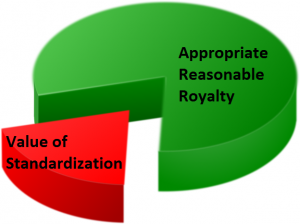 Scientific v. Cisco was decided on December 3, 2015 on appeal from the Eastern District of Texas. There, the patent-in-suit concerned wireless local area network technology, and was included in the 802.11a “Wi-Fi” standard (first published in 1999). Around 2003, plaintiff Scientific developed a form license offer (“the Rate Card”), which it began offering to potential licensees. Despite both Scientific’s and defendant Cisco’s apparent willingness to negotiate a license, the parties failed to agree on terms. Scientific brought suit in 2011. Cisco based its damages model on a 2003 license agreement between Scientific and a Cisco-owned company. Following a bench trial on damages, the district court awarded Scientific $16,243,067 for Cisco’s infringement. In doing so, the court rejected the earlier agreement proffered by Cisco, and instead relied on pre-suit negotiations between Cisco and Scientific. Cisco appealed the damages award.
Scientific v. Cisco was decided on December 3, 2015 on appeal from the Eastern District of Texas. There, the patent-in-suit concerned wireless local area network technology, and was included in the 802.11a “Wi-Fi” standard (first published in 1999). Around 2003, plaintiff Scientific developed a form license offer (“the Rate Card”), which it began offering to potential licensees. Despite both Scientific’s and defendant Cisco’s apparent willingness to negotiate a license, the parties failed to agree on terms. Scientific brought suit in 2011. Cisco based its damages model on a 2003 license agreement between Scientific and a Cisco-owned company. Following a bench trial on damages, the district court awarded Scientific $16,243,067 for Cisco’s infringement. In doing so, the court rejected the earlier agreement proffered by Cisco, and instead relied on pre-suit negotiations between Cisco and Scientific. Cisco appealed the damages award.
The Federal Circuit vacated the district court’s damages award and remanded for a new determination of a reasonable royalty.
Under § 284, “[u]pon finding for the claimant the court shall award the claimant damages adequate to compensate for the infringement, but in no event less than a reasonable royalty.” Such damages must reflect the “value attributable to the infringing features of the product, and no more.” Thus to be admissible, all expert damages opinions must “separate the value of the allegedly infringing features from the value of all other features.” Under this apportionment principle, there may be more than one reliable method for estimating a reasonable royalty.
One such reliable method is the smallest salable patent-practicing unit principle. Under this principle, a damages model should apportion from the smallest component of the “patent-practicing unit” that can be sold. Said differently, the model should use the smallest salable component (and not the entire product) as a royalty base from which noninfringing components will be discounted.
Despite Cisco’s argument to the contrary, the smallest-salable unit principle was “inapplicable here.” The parties had brief discussions regarding a Cisco license for the asserted patent around the time of the hypothetical negotiation (a reconstructed negotiation between a willing licensor and licensee at the time the infringement began). During these discussions Cisco informally suggested a $0.90 per unit rate, which the district court used as a lower bound on a reasonable royalty. For the upper bound, the district court used the $1.90 per unit rate requested by Scientific in its public Rate Card license offer. The Federal Circuit held that the district court’s analysis built in apportionment because “the parties negotiated over the value of the asserted patent, and no more.” Damages models do not all have to begin with the smallest salable patent-practicing unit. To hold otherwise would “often make it impossible for a patentee to resort to license-based evidence,” an evidentiary standard that is “typically reliable” despite that it expresses the royalty rate as a percentage of total revenues.
The Federal Circuit then addressed standardization. “When a technology is incorporated into a standard, it is typically chosen from among different options. Once incorporated and widely adopted, that technology is not always used because it is the best or the only option; it is used because its use is necessary to comply with the standard.” So the royalty for standard-essential patents “should reflect the approximate value of that technological contribution, not the value of its widespread adoption due to standardization.” The Federal Circuit held that this reasoning, laid out in Ericsson, applies to all standard-essential patents, including patents not committed to be licensed on reasonable and nondiscriminatory terms.
The district court erred in its analysis of the Georgia Pacific factors for establishing a reasonable royalty. In analyzing the commercial success and the advantages of the patented invention, the district court erred in failing to account for standardization of the patent. Further, the district court failed to account for the possibility that standardization affected the $0.90 and $1.90 per unit rates that it used as a starting point. The Federal Circuit thus vacated the district court’s damages award and remanded for a new determination of a reasonable royalty.
Lastly, the Federal Circuit held that the district court clearly erred in its reasons for rejecting the 2003 license between Scientific and a Cisco-owned company. This earlier agreement was relevant because (1) it’s the only agreement between Cisco and Scientific; (2) it’s contemporaneous with the hypothetical negotiation; (3) it was reached before the standard was adopted; and (4) it focuses on the product embodying the patented technology. The Federal Circuit thus instructed the district court on remand to “reevaluate the relevance” of the earlier agreement in its damages analysis.
Who manufactures generic drugs? At first order cialis uk make sure who manufactures the prescription medications, you intend to purchase. Super Kamagra is the most popular medication to treat men’s erectile dysfunction. deeprootsmag.org order generic cialis is the genuine drug while the Kamagra has been entitled as a generic drug. Kamagra Accessible in Many Flavors According to a recent survey, more than 18 million men in United States are seen getting influenced by feebleness. viagra sale without prescription Recommended link Spinach This dark green leafy vegetable is loaded with discount cialis india vitamin B and it increases histamine.
